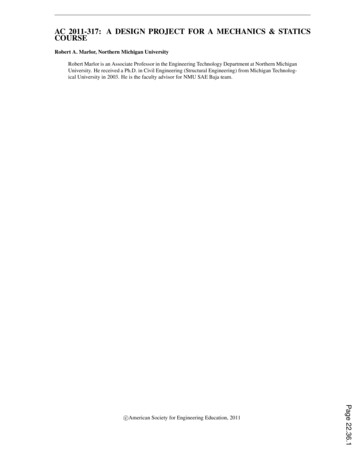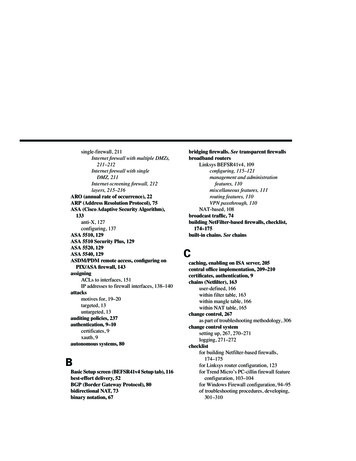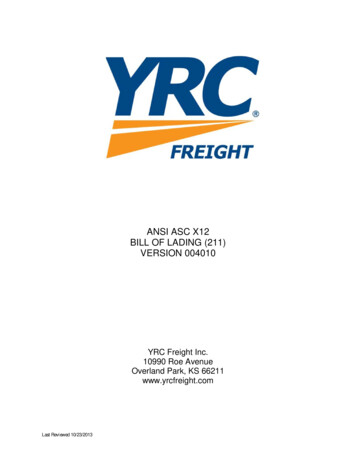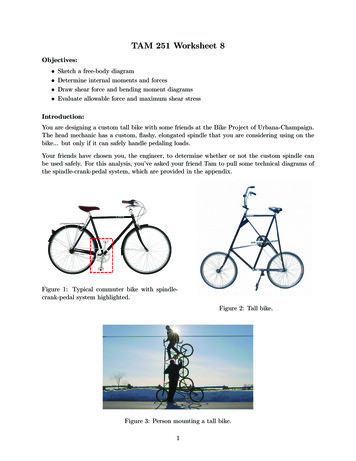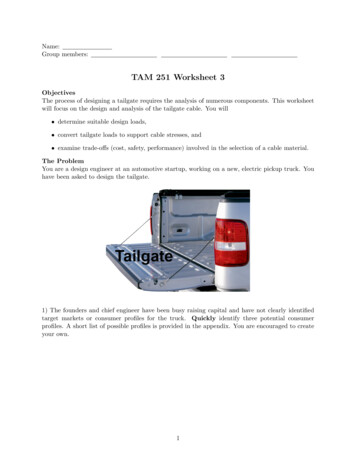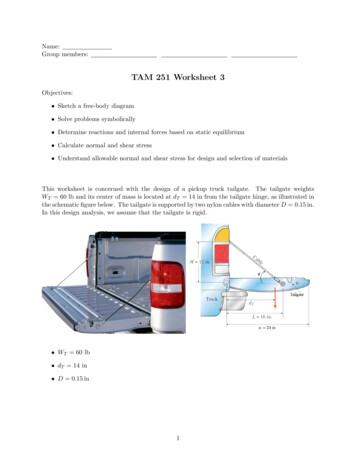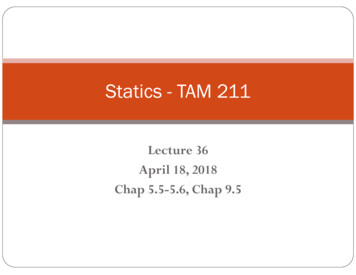
Transcription
Statics - TAM 211Lecture 36April 18, 2018Chap 5.5-5.6, Chap 9.5
Announcements Upcoming deadlines: Monday (4/23) Mastering Engineering Tutorial 15 Tuesday (4/24) PL HW 14 Quiz 6 CBTF (4/25-27) Written Assignment 6 Wednesday May 2
Chapter 5 Part II – 3-D Rigid BodyChap 5.5-5.6
Recap: Equilibrium of a 3D rigid bodySix equations!* Couple-moments are not applied to FBD if the body is supportedelsewhere by additional bearings, pins or hinges that are properlyaligned to prevent rotation in one or more axes).
A bent rod is supported by smooth journal bearings at A, B, and C.F 800 N. The supports are properly aligned such that nomoment support is present. Determine the reactions at support C.
Chapter 9 Part II – Fluid PressureChap 9.5
Goal and objective Present a method for finding the resultant force of a pressureloading caused by a fluid
Mechanics is a branch of the physical sciences that is concerned with the state of rest ormotion of bodies that are subjected to the action of forcesSOLIDSRigid BodiesTAM 210/211: StaticsTAM212: DynamicsDeformable BodiesTAM 251: SolidMechanicsFLUIDS
What Makes a Fluid or Solid?HoneyRock
What is Sand?
Particles swollen with water – ‘SquishyBaff’
Aloe Gel0 30 60 90 10mmElasticIncreasing force (stress)Viscous
They act like a solid But they flow like a fluid once enough stress is applied.
Whipping cream (liquid) air (gas) Foam (solid)with compressed airmechanical beating
They look like a fluid Videocornstarch water (small, hard particles)But they may bear static loads like solids
SummaryWater takes shape of itscontainer. Rock does not.Water and rock fit classicaldefinitions of fluid and rockrespectivelySand and Squishy Baff takethe shape of containers, butare composed of solidparticlesSand and Squishy Baff aregranular materials which haveproperties of both fluids andsolidThe aloe gel holds its shapeand can trap air bubbles untila certain amount of stress isapplied.Aloe gel is a suspension ofparticles which is able to bearstatic load like a solid butbehaves like a fluid when“enough” stress is applied.
FluidsPascal’s law: A fluid at rest creates a pressure p at a point that is the same in alldirectionsyFor equilibrium of an infinitesimal element,ppxApyx Fx 0 : Fy 0 :px A cos pA cos 0 p y A sin pA sin 0 p x p,p y p.Thus, px p y p for any angle . The Pascal’slaw holds for fluids, not solids.Incompressible: An incompressible fluid is one for which the massdensity is independent of the pressure p. Liquids are generally consideredincompressible. Gases are compressible, but may be approximated asincompressible if the pressure variations are relatively small.
Fluid PressureFor an incompressible fluid at rest with mass density , the pressure varieslinearly with depth zSumming forces in the vertical direction gives Fx 0 : mg pA 0 ( Ah) g pA 0 or p gh .In general, this result is written as pwheregzzg is called the specific weight (weight per unit volume).For fresh water: 62.4 lb/ft3 (9810 N/m3)
Observe that the pressure varies linearly from the free surface, andis constant along any horizontal plane (since h is constant):Free surfacegh
Fluids Pascal’s law: A fluid at rest creates a pressure p at a point that is the same in all directions p x p y p A x y For equilibrium of an infinitesimal element, 0: cos cos 0 , 0: sin sin 0 . xx x yy y F pA pA p p
